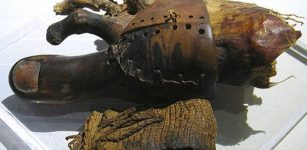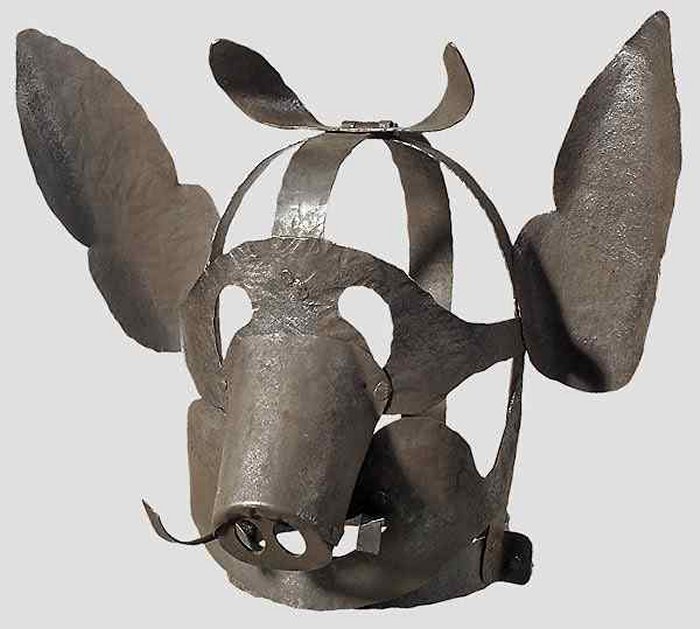Mask Of Shame: Worn In Ancient Times As Punishment For Gossiping
Conny Waters - AncientPages.com - Have you indulge in gossiping and talking badly behind peoples' back?
A medieval "Mask of Shame", or scold's bridle. A medieval "schandmaske", or mask of shame, in the Fortress Museum, Salzburg, Austria. Image credit: Klaus D. Peter, Wiehl, Germany - CC BY 3.0
If so, be happy you were not living during the medieval period and the Renaissance.
In those days, there were certain methods, rituals, and punishments to control and condemn such misbehavior. One way of punishing a gossiper was to force him or her to wear the Mask of Shame.
The Mask of Shame was called the Schandmaske in Germany.
People throughout the region used such masks well into the eighteenth century, the same time as the Enlightenment and the American and French revolutions.
Image credit: Brandals Hauffen
The purpose of the masks was simple: individuals who committed a social faux pas (or crime) would have to wear it, revealing to their community what they had done.
Look closely at the Mask of Shame at the first image to the left, and you will find an unusual nose.
It was deliberately crafted to look like a pig's snout because the whole point was to demonstrate to others that the wearer acted like a pig.
Reinforcing cultural norms and expectations were certainly important enough for Europeans to develop such interesting and unusual methods.
However, to what extent these controversial methods were successful - that we cannot tell you.
Written by Conny Waters – AncientPages.com Staff Writer
Updated on January 6, 2024
Copyright © AncientPages.com All rights reserved. This material may not be published, broadcast, rewritten or redistributed in whole or part without the express written permission of AncientPages.com
More From Ancient Pages
-
 On This Day In History: Mary Queen Of Scots Was Forced To Abdicate – On July 24, 1567
News | Jul 24, 2016
On This Day In History: Mary Queen Of Scots Was Forced To Abdicate – On July 24, 1567
News | Jul 24, 2016 -
 Secret Archaeological Excavations Have Led To The Discovery Of An Extremely Rare Ancient Roman Gold Treasure In Parc Hosingen, Luxembourg
Archaeology | Jan 20, 2025
Secret Archaeological Excavations Have Led To The Discovery Of An Extremely Rare Ancient Roman Gold Treasure In Parc Hosingen, Luxembourg
Archaeology | Jan 20, 2025 -
 3,000-Year-Old Egyptian Artificial Wooden Toe In New Light
Archaeology | Jun 20, 2017
3,000-Year-Old Egyptian Artificial Wooden Toe In New Light
Archaeology | Jun 20, 2017 -
 Remarkable Kailashanatha Temple And Unique Passage Of Life Cycle Including Aging, Death And Rebirth
Civilizations | Mar 26, 2017
Remarkable Kailashanatha Temple And Unique Passage Of Life Cycle Including Aging, Death And Rebirth
Civilizations | Mar 26, 2017 -
 Rare Ancient Roman Cauldron Discovered In Central Norway
Archaeology | Sep 16, 2019
Rare Ancient Roman Cauldron Discovered In Central Norway
Archaeology | Sep 16, 2019 -
 LIDAR Discovers Huge Abandoned Zapotec City With Temples, And Ball Courts In Oaxaca, Mexico
Archaeology | Jan 30, 2025
LIDAR Discovers Huge Abandoned Zapotec City With Temples, And Ball Courts In Oaxaca, Mexico
Archaeology | Jan 30, 2025 -
 Tiny Tools And Skills Of Mysterious Toaleans People In Southernmost Sulawesi, Indonesia
Archaeology | May 27, 2021
Tiny Tools And Skills Of Mysterious Toaleans People In Southernmost Sulawesi, Indonesia
Archaeology | May 27, 2021 -
 Why Was The Iron Age Village Near Elgin In Scotland Suddenly Abandoned And Burned Down?
Archaeology | Jul 29, 2022
Why Was The Iron Age Village Near Elgin In Scotland Suddenly Abandoned And Burned Down?
Archaeology | Jul 29, 2022 -
 On This Day In History: Vatican Began 7-Year-Long Trial Against Giordano Bruno – On Jan 27, 1593
News | Jan 27, 2017
On This Day In History: Vatican Began 7-Year-Long Trial Against Giordano Bruno – On Jan 27, 1593
News | Jan 27, 2017 -
 Pazyryk Carpet: Extraordinary Craftsmanship Of Siberian Iron Age Textile Dyers
Archaeology | Mar 5, 2021
Pazyryk Carpet: Extraordinary Craftsmanship Of Siberian Iron Age Textile Dyers
Archaeology | Mar 5, 2021 -
 Ethical Ancient DNA Research Must Involve Descendant Communities – Researchers Say
Archaeology | Jan 13, 2023
Ethical Ancient DNA Research Must Involve Descendant Communities – Researchers Say
Archaeology | Jan 13, 2023 -
 Those Who Mysteriously Disappeared To A World Beyond Human Understanding
Featured Stories | Apr 30, 2019
Those Who Mysteriously Disappeared To A World Beyond Human Understanding
Featured Stories | Apr 30, 2019 -
 Findings From The First Temple Period Discovered In The City of David Corroborate A Biblical Event
Archaeology | May 4, 2024
Findings From The First Temple Period Discovered In The City of David Corroborate A Biblical Event
Archaeology | May 4, 2024 -
 Unusual Medieval Knife Used Like An Eraser Discovered In Poland
Archaeology | Feb 16, 2018
Unusual Medieval Knife Used Like An Eraser Discovered In Poland
Archaeology | Feb 16, 2018 -
 The Hidden History of China’s Secret Societies
Featured Stories | Nov 23, 2014
The Hidden History of China’s Secret Societies
Featured Stories | Nov 23, 2014 -
 On This Day In History: World War II: Battle Of Cape Esperance Was Fought – On October 11, 1942
News | Oct 11, 2016
On This Day In History: World War II: Battle Of Cape Esperance Was Fought – On October 11, 1942
News | Oct 11, 2016 -
 Science Fiction Was Around In Medieval Times – Here’s What It Looked Like
Featured Stories | Sep 18, 2018
Science Fiction Was Around In Medieval Times – Here’s What It Looked Like
Featured Stories | Sep 18, 2018 -
 Remote North Atlantic Islands Were Settled By An Unknown Group Of Humans Centuries Earlier Than Thought
Archaeology | Dec 27, 2021
Remote North Atlantic Islands Were Settled By An Unknown Group Of Humans Centuries Earlier Than Thought
Archaeology | Dec 27, 2021 -
 Huge Ring Of Ancient Shafts Discovered Near Stonehenge
Archaeology | Jun 22, 2020
Huge Ring Of Ancient Shafts Discovered Near Stonehenge
Archaeology | Jun 22, 2020 -
 Bandelier National Monument: Unusual Ancient Ruins Of Pueblo People In The Southwest
Civilizations | Jun 30, 2016
Bandelier National Monument: Unusual Ancient Ruins Of Pueblo People In The Southwest
Civilizations | Jun 30, 2016


